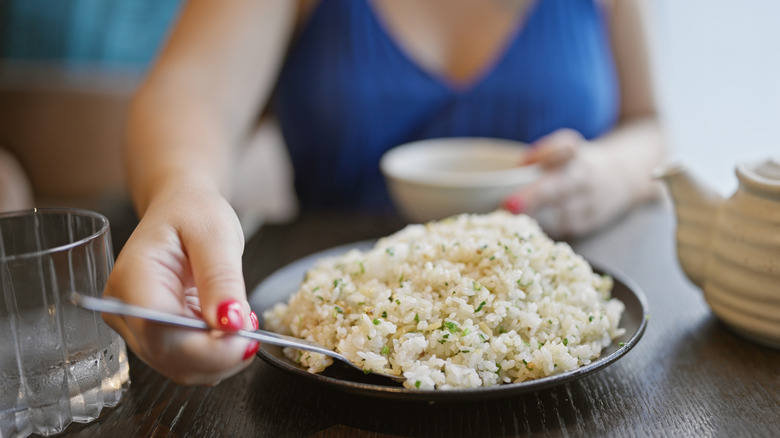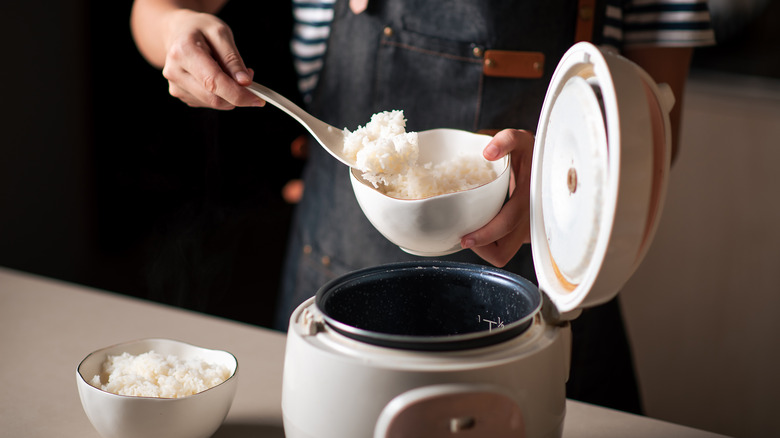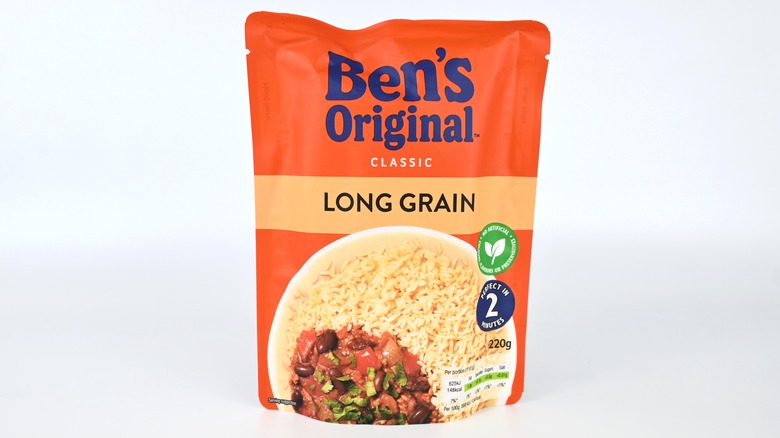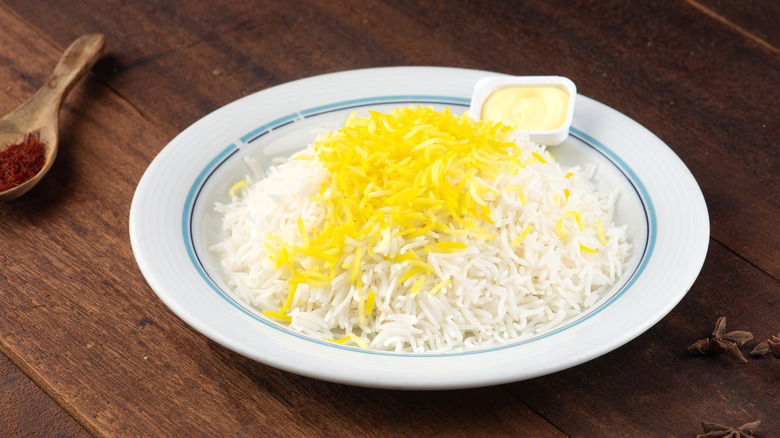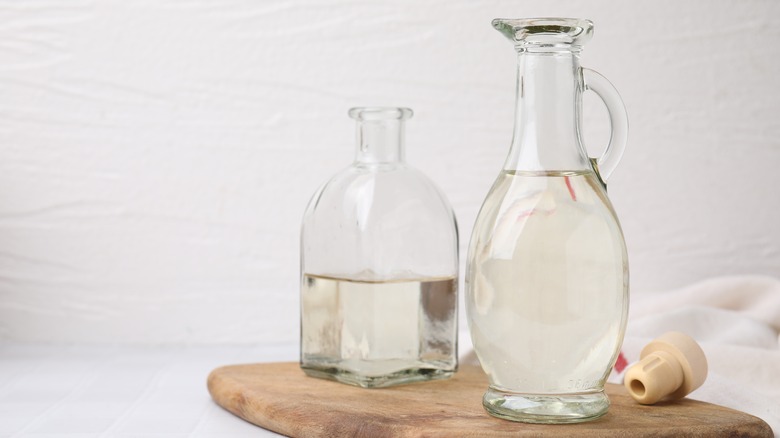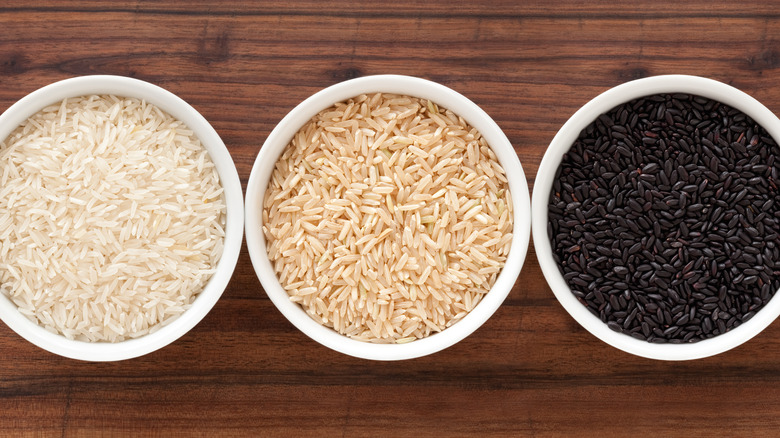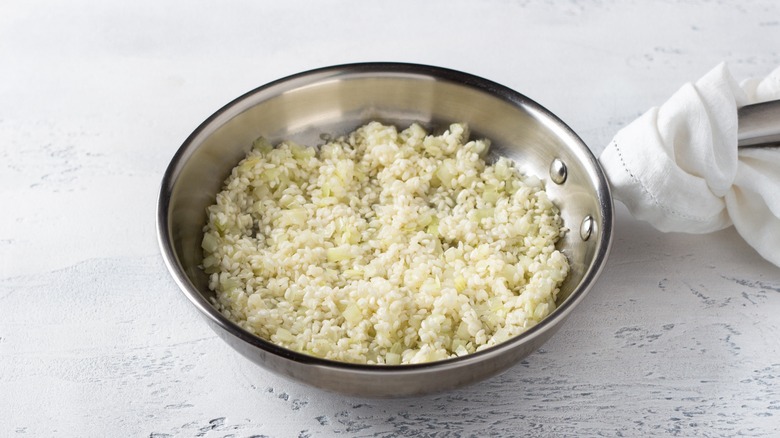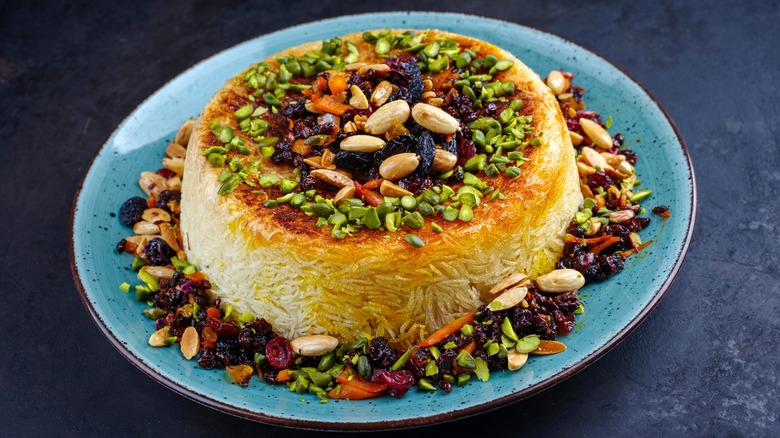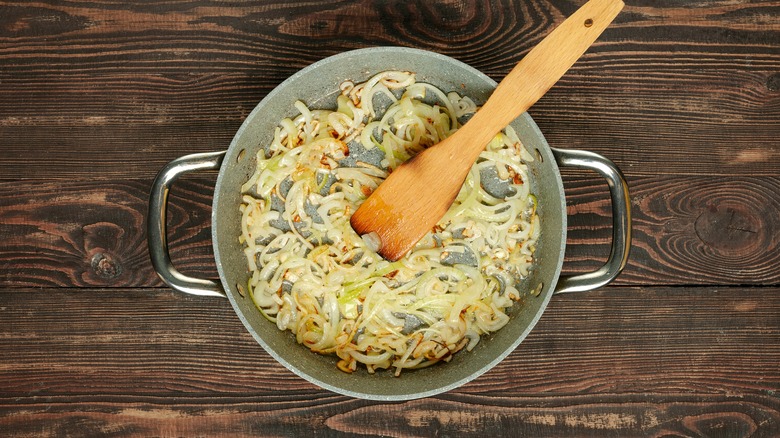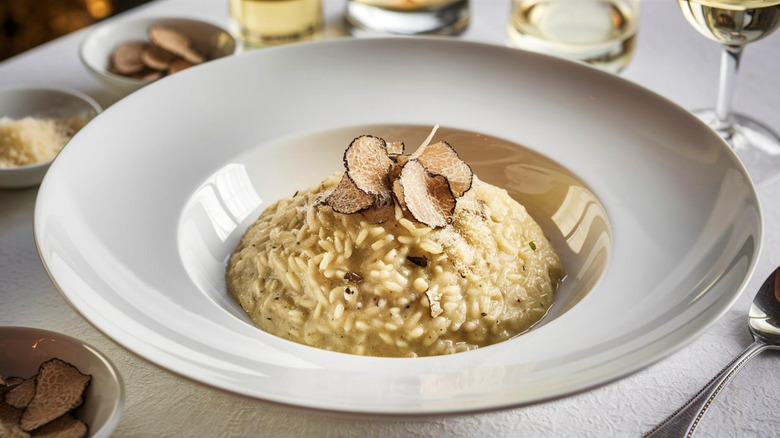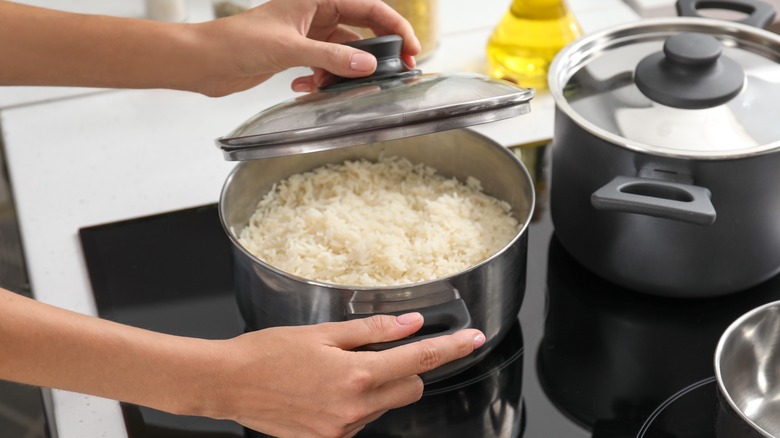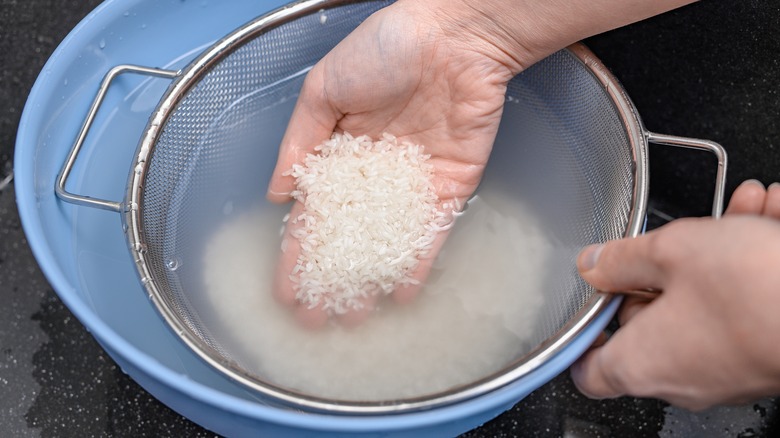Why Rice Is Always Better At A Restaurant
Rice is an incredibly versatile food. You can eat it as a side for Thai curries or Jamaican jerk dishes, it cooks into meals like risotto and biryani, you can fry the leftovers into a whole new dinner, and so much more. But do you ever get disappointed that the rice you cook at home is never as good as what you get at a restaurant? Rather than fluffy or sticky, homemade rice can come out chalky or mushy. And perhaps you can never get the flavor right, either.
But the time has come to stop being disappointed by the rice you make at home. We've done the research to discover why rice is always better at a restaurant. Using the secrets of professional chefs, you can learn what to do and what not to do so your rice comes out perfectly every time.
Whether you want to get better at making complex rice dishes, like paella or jollof rice, or you just want to learn how to make decent boiled basmati, we've got your back. While some of the reason why restaurant rice tastes better is down to equipment — such as commercial rice cookers — much of it is down to technique and ingredients, meaning you can learn to get similar results at home. You'll never have to struggle your way through tasteless or stodgy rice again — read on to find out how to get restaurant-quality rice at home.
Restaurants often use commercial rice cookers
Restaurants that serve a lot of rice, such as Chinese or Indian restaurants, often use commercial rice cookers. These not only make it simple to cook large batches of rice in a hands off manner, leaving chefs free to attend to other tasks, but they can also safely keep it warm after cooking. This is the perfect solution for restaurants because they have to serve various tables at different times and they can't make up a fresh pot of rice for every order they get in.
Commercial rice cookers offer consistent results with settings for different types of rice and a huge capacity. While you're not going to want a commercial appliance at home — unless you happen to have a giant kitchen and a huge family — home rice cookers are also excellent. Some people might baulk at the idea of buying an appliance just to do one job, but so many people wax lyrical about their rice cookers, saying it's the best kitchen purchase they've ever made.
If you love rice but find cooking it a pain or struggle getting it right, it's worth considering one of these gadgets. You can buy perfectly good ones from around $20, but there are also high-end machines with all the bells and whistles if you want the best results and don't mind spending extra. Zojirushi rice cookers have a great reputation.
Chefs never use instant rice
Tempted by the allure of quick and easy meals? Well, don't get sucked in by instant rice or microwave rice. There's a good reason why chefs never buy pre-made rice: it's just not as good.
Instant rice can refer to the kind of cooked, dehydrated rice that you have to boil for a handful of minutes or the type that's fully cooked and needs reheating in the microwave. But, either way, you should avoid it. For both types of product, the taste and texture just isn't right. Minute rice — the dehydrated kind — never fully rehydrates and always ends up kind of dry. Microwave rice isn't as dry, but it's neither fluffy nor sticky, so it isn't the perfect side for any dish.
It doesn't taste great, either. Rice might be simple but it's surprisingly flavorful, even when eaten plain. Instant rice has been pre-cooked, then packaged or dehydrated and that ruins the flavor. It's a bit like the difference between a packaged grocery store sliced white loaf and a sourdough boule from a bakery.
The other thing is that it's way more expensive than regular rice. You're paying for the convenience but rice isn't all that inconvenient to make, anyway. There's the rinsing step, but after that it just simmers away for 15 minutes or so. It really isn't worth the downsides of instant rice to save a tiny bit of time.
Restaurant-quality rice may contain butter or oil
Restaurant rice can be particularly rice and flavorful. Sometimes, this is down to the addition of butter, oil, or ghee — a clarified butter common in Indian cuisine. It's a simple ingredient that can make all the difference to the quality of your finished grains. But, it's not suitable for every dish, so think carefully before adding it.
Yes, fats bring flavor but they also coat the grains and stop them from sticking together. This means it's a helpful ingredient when you want to make fluffy rice with separated grains, such as basmati to go with a korma. However, it's best to avoid adding oil or butter when you want to make sticky rice, such as the kind you need for sushi or to go with certain Thai dishes.
If you want to use oil or butter, add around half to one tablespoon for every serving of rice you're making. Add it along with the water or stock and simmer. That said, another option is to add butter after cooking, gently mixing it into the rice while fluffing it with a fork. This can give you a more pronounced buttery flavor.
Chefs choose high-quality rice
When you buy rice, you probably pick up whatever bag you can find at the supermarket. Chefs, on the other hand, often choose high-quality rice. They know the difference between good and lackluster rice and what difference this can make once it's cooked. If you have your technique down but your rice is still disappointing, you might just need to choose a better brand.
The quality often comes down to the variety, how it's grown, and the milling process. Premium brands tend to have better aroma, texture, and flavor. Look for rice that's aged — like aged basmati, which cooks up fluffier — or carries certifications of origin. It's often better to opt for brands from regions known for specific types of rice, such as basmati from India or jasmine from Thailand. Specialty stores, Asian markets, and even some online retailers are great places to find high-quality options.
While chefs might have insider insight into the best brands and access to culinary suppliers, it's still possible to buy great rice as a home cook. Don't just grab the cheapest rice you can find and, if in doubt, ask someone at a specialty store for recommendations. You can find your favorites through trial and error, even if it's a tough task having to eat your way through different types of delicious rice.
Rice at restaurants may have vinegar added to the water
The perfect rice texture can be elusive. The layer of starch on the outside — caused by grains rubbing up against one another during the packaging process, transit, and storage — can lead to mushiness. But, you can counteract this effect by cooking your rice with some vinegar.
The acidity from the vinegar helps to rinse the starch from the grains, keeping it from getting mushy and gloopy. It's great for various rice styles. It can lead to fluffier rice when you're looking for separated grains but it can also give you sticky results without the finished pot being overly sticky or congealed.
If you're not sure about adding vinegar because you're worried about the flavor, you needn't worry. You only need to add around a teaspoon of vinegar per two cups of liquid used. This isn't enough to lend a significant vinegar note to your rice. If there is a slight tang, it will be subtle enough to meld in with a range of flavors — just the right amount to create balance without being overly sour or acidic.
Chefs know the nuances of cooking different types of rice
It's easy to assume that all rice should be treated the same. But the fact is that different varieties cook in their own ways. Some take longer than others, some need more liquid, and this can lead to confusion and subpar results. But chefs are trained professionals and understand the nuances of cooking each variety, which is why the stuff at restaurants is so much tastier.
Chefs know every type of rice and what it's best used for, as well as how to cook it so it will turn out brilliantly. They know that basmati rice is the perfect accompaniment to Indian curries. And, they understand it should be simmered, covered, for around 10 to 15 minutes, in around 1 to 1.5 times its volume of water or other liquid until the liquid has evaporated, and then left to steam. But, by contrast, they understand that brown rice takes much longer to cook — around 45 minutes — and requires more liquid in the pot. Attempting to cook it the same way as white basmati rice will leave it seriously undercooked.
If this seems daunting to you, start by learning to make your favorite kind of rice. Once you've perfected this and understand what it needs, you can move onto different varieties until you know exactly how to cook them all.
Restaurant rice may be toasted before boiling
You probably think that all rice is made in roughly the same way. You throw it in a pot with water, stock, or other liquids like coconut milk, put a lid on it, and let it simmer away. This is one option but there are other ways. If your favorite restaurant rice is particularly flavorful, it may have been toasted prior to boiling.
Michael Symon has a rice toasting technique that levels up the flavor. This isn't Symon's idea alone. It's a known way of preparing rice that's endorsed by many top chefs, including Alton Brown. Yes, it adds an extra few minutes to the cooking process but the trade-off in flavor is definitely worth it.
To toast rice, you first add fat to the cooking pan. This might be oil, butter, or ghee. You can tailor this depending on the dish you're making. For instance, ghee might be best for an Indian or Pakistani dish, while olive oil is a better choice for a Middle Eastern or Mediterranean recipe. Once the fat is hot, add the rice and cook it for a few minutes, stirring regularly, until it becomes fragrant. Then you add the liquid and continue cooking it as normal. This brings out the nutty flavors in the rice, making it more complex and delicious.
Chefs go beyond basic rice dishes
What might make the rice at your favorite restaurant so good is that chefs go beyond basic dishes. While it's impressive when food spots can make just basic plain white rice taste good enough to happily eat on its own, what you might be particularly envious of is the range of great rice dishes in their repertoire. Perhaps you know how to make a basic risotto or an alright fried rice, but chefs can go way beyond these basic dishes.
For instance, your favorite Iranian or Persian restaurant might serve rice tahdig style, with a deliciously crispy bottom. Or your Indian restaurant favorite may be a delicious pilau, which seems simple but is tricky to make as perfectly as the experts do. There are so many amazing rice dishes from around the world: pilaf, nasi goreng, jambalaya, bibimbap — the list goes on. There are even sweet options like mango sticky rice or even a good old fashioned rice pudding.
If you're jealous of all the creative ways to cook with rice, there's only one thing for it: You'll have to learn to make them yourself. Or you'll have to resign yourself to eating out more. Either way.
Restaurant-quality rice may contain aromatics
If your go-to rice technique is to add rice and water to a pan, maybe a pinch of salt if you're feeling fancy, and simmer it until it's cooked, you need to reconsider. The reason why restaurant rice tastes better than this is because it may contain aromatics. It seems obvious — they're those ingredients that add extra flavor, after all. And if you need reassurance, aromatics are key in Martha Stewart's method for perfect rice.
But, first, what are aromatics? Well, they're simply the ingredients you add to a dish to create a base of flavor. Onions are the obvious one. Also carrots and celery if you're creating a mirepoix, or a combination of onions, celery, and green pepper if you're making a base for Cajun food — this is known as the holy trinity. Then there are ingredients like garlic, ginger, and lemongrass. And, of course, herbs and spices.
To incorporate aromatics in your rice, start by sautéing them in a little oil or butter. You might use the holy trinity for a Cajun rice and beans dish or onions, ginger, garlic, and whole cardamom pods for an Indian-inspired rice dish. Think about what other foods you're serving it with and adjust the flavors accordingly. Next, add rice and let it toast, before pouring in the cooking liquid and letting the whole lot simmer with a lid on the pot. That's one way to get super flavorful rice.
Chefs know which rices are fluffy and which are sticky or creamy
Where you can end up going wrong with rice is not understanding the texture you're aiming for. But chefs know which rices are fluffy and which are sticky or creamy. Knowing what texture to aim for and what different rice varieties offer is a big part of getting excellent rice.
This is all down to the starch content in the rice. There are two main types of starch in rice: amylose and amylopectin. Rices that have greater amounts of amylopectin become sticky or creamy while cooking. On the other hand, varieties that have more amylose cook up fluffier with separate grains. This is why, no matter what technique you used, you could never get basmati rice to make a creamy risotto. Or, if you're looking for rice with a fluffy texture and separated grains, sushi rice is a poor choice.
It's important to understand the strengths and weaknesses of the varieties you're working with and to learn what type of rice a certain dish needs. Any good recipe will specify which variety you should use, or several varieties that work equally well. Try to follow this advice or your dish won't turn out the way it was intended.
Rice from restaurants is allowed to steam
When you have rice with a perfect texture, that's because it has been allowed to steam. Steaming is vital to cooking rice properly because it ensures even heat distribution and moisture absorption. As the steam penetrates the grains, it cooks them gently from the inside out, making them tender and fluffy rather than mushy or undercooked. That's why chefs like to use this technique.
Without proper steaming, you might end up with unevenly cooked rice. You can wind up with some grains too soft and others still crunchy. So, how do you steam rice? Basically, you just stick a lid on the pot. Put the lid on as you're bringing the water to the boil, then turn the heat right down, and keep the lid on. Don't be tempted to lift it for anything. You'll release the built-up steam and end up with subpar results.
You don't need to stir rice while it's cooking and there's no need to peek. If you really dislike not being able to see how it's doing, choose a saucepan with a clear lid. Depending on the recipe or cooking technique. You may leave the lid on for around 10 to 20 minutes after taking it off the heat. This lets it steam more and finish cooking gently, further helping it to achieve the dream texture, whether sticky or fluffy.
Chefs understand when to rinse rice and when not to
Chefs know when to rinse rice and when to just leave it, which helps with getting the perfect texture. You've probably heard you should wash rice, and maybe you even do it. But there are some times when it's better not to. Learning when to go for each option will give you better results across the board.
First, rinsing. This is when you swirl the rice in clean water, drain it off, and continue until the water is mostly clear. It can seem like an annoying step but it really makes a difference. We're not in favor of doing unnecessary kitchen tasks just for the sake of it, but once you start washing rice, you'll realize how much better it makes the texture. You'll end up with rice that's either fluffy or just the perfect level of sticky, if that's what you're after. Failing to rinse it can make rice turn mushy.
You almost always need to wash rice, so it's better to learn when not to do so. When you want a dish to come out exceptionally creamy, you need the extra starch and shouldn't rinse it. There are only a few cases when you shouldn't rinse, such as when making risotto, congee, or rice pudding.
